![[]](./bin/ailogo.gif)
Website Provider: Outflux.net
URL:http://jnocook.net/texts/books.htm
Photographic BOOKS -- Jno Cook
This was part of a handout about visual books for a class. I have
dropped the arcane references to book in the middle ages, and some other
forms, and just retained here the core of "photographic" books, and a few
I really like.
19th Century and earlier
These are photographic (or photo-based books) worth
seeing. I'm not listing books which are just retrospectives and
collections (except a few), they are seldom interesting and never have a
theme. I am listing some books other than photographic books if they are
of some importance to the visual arts community.
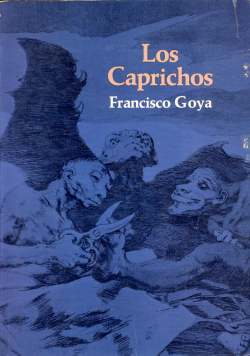 |
Fransisco Goya's "Los Caprichos" (1799), is a portfolio of single prints.
There is a 1969 Dover reprint. Always great to look at again. If you could
photograph like he draws, you would be the formost cultural critic of
today. |
The 19th Century sees the development of offset
printing methods, and high-speed machinery. By the end of the century the
half-tone process has been developed, and already multicolored images are
found in books, magazines and catalogues. Although color photography had
to wait until 1936, color separations were made since the 20's (the
3-color additive printing process dates from the middle of the 19th
century).
But mostly throughout the 19th century, and increasingly since
photography became available, illustrations -- in woodcut and engravings
-- were the property of magazines and catalogues.
Check out, for example, Honoré Daumier, 1808 - 1879,
who produced some 4000 engravings for weekly newspapers between 1830 and
1870. But it's not a book. That is, it is not presented as a definitive
collection, like Goya's work. And these illustrations depended heavily on
captions. After 1865, however, photography enters the book.
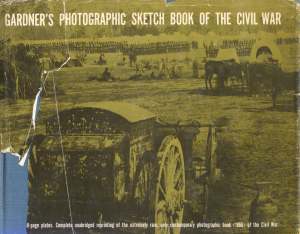
| Alexander Gardner "Photographic Sketch Book of the Civil War"
(1866), in two volumes, 100 tipped-in photo prints (Dover reprint 1959).
There is a text apposed to each photo. |
There was a question, for Gardner as for Emerson
(below), as to whether photographs could be presented without text, or
with just a minimal text. Only Muybridge (below), in the 19th century,
got away without text, for his photographs were presented only as visual
evidence.
| P. H. Emerson: "Life and Landscape on the Norfolk Broads" (1886),
and five more like this up to 1893. Most are illustrated in gravure, a
process which comes as close -- in ink -- as possible to looking like an
actual photograph, and all carry texts. Emerson's books became the model
for illustrated ethnographic picturebooks for the next 50 years. Shown is
a 1975 biographical compilation of Emerson's work by Nancy Newhall.
| 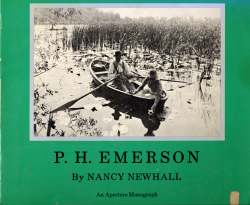
|
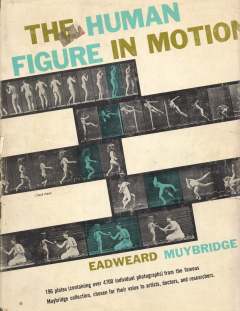
| Eadward Muybridge "Animal Locomotion" (1887), in 11 volumes (!)
These are 781 "studies" each composed of 20 to 40 photographs each, that
is, per page, for a total of some 24,000 photographs! The exhaustiveness
is overwhelming. There's a "Human Locomotion", too. Reyerson has a number
of copies, some with carefully removed human body parts. Original
printings were in colotype. Shown here is a 1955 reprint of "Human
Locomotion." |
Early 20th Century
Throughout the 19th and most of the 20th century the
use of photographic books remains directed toward ethnographic (when it is
'them') and photojournalistic (when it is 'us') uses, and, of course, the
sort of travel pictures from strange places and foreign lands (they start
as early as 1852 with "Egypte, Nubie, Palastine et Syrie", as engravings
from Daguerreotypes). And then there are all those how-to manuals. A few
stand out as interesting, but all of them depend on text.

| W.A. Bentley "Snow Crystals" (1931) (Dover reprint 1962) An
unbelievable collection of 2500 snow flake images, page after page after
page, all taken with an 8x10 camera in freezing weather. But no supporting
text. |
| Brassaï "Paris de Nuit" (1933), reprinted as (although not
the same book) "The Secret Paris of the 30's" (1976). | 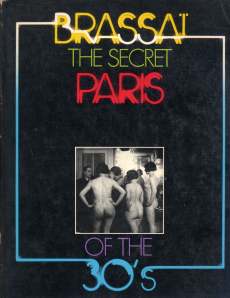 |
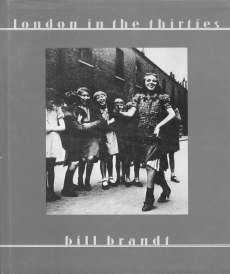
| Bill Brandt "The English at Home" (1936) "London in the thirties"
(1983) is a recent compilation. |
Dorothea Lang and Paul Taylor "An
American Exodus" (1939) The classic Lang book on the depression, and the
farmer migration to California.
Edward Weston "California and the West" (1940, 1979) and "The
Daybooks of Edward Weston" (1961, 66, 2 vol). The daybooks are interesting
reading, but selfconsciously edited. | 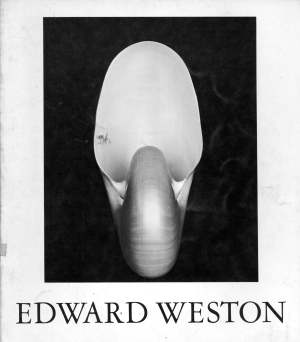 |
 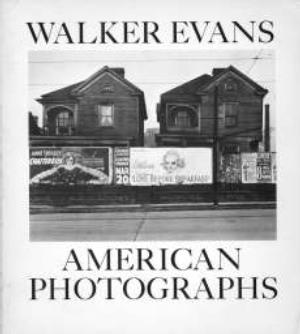
| Walker Evans and James Agee "Let Us Now Praise Famous Men"
(1939, reprinted in 1960 and 1966, 1975, 1989). Only some 60 photographs,
which precede the text and even the title page of the book. And a
heart-wringing text of hundreds of pages by Agee, which must have cost him
his soul to write.
But Evans' reputation rests mostly on "American Photographs" (1938),
which is actually an exhibition catalogue put out by MoMA, and reprinted
in 1962. Embarrassingly for the Museum, the catalogue was entirely put
together by Evans and critic Greenberg -- for the curator was away at the
time of the exhibition. "American Photographs" sold only a few copies, but
it was one of the most influential books of the 40's and 50's. Walker's
best work may be "Messages from the Interior" 1966, which is only 12
photographs. |
| Weegee (Arthur Felling) "Naked City" (1945). A newspaper
photographer living out of his car in the 40s. Shown here is a 1973
reprint. | 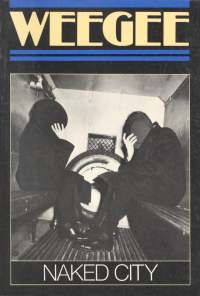 |

| Wright Morris "The Inhabitants" (1946) "The Home Place" (1948)
"God's Country and My People" (1968). Some of it is in the tradition of
Walker Evans, but somehow the aesthetic is not the same. |
After the middle of the 20th Century
Henri Cartier-Bresson
"The Decisive Moment" (1952) This presented a photographic approach which
suggested that intelligent camerawork could usurp for the professional the
candids which so often fell into the lap of the amateur. It became a
cul-du-sac, however, in that the professionals were deadlocked in a race
for precision, with Cartier-Bresson in the lead.
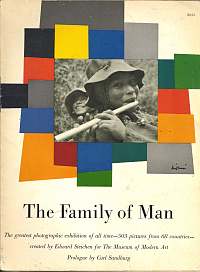
| What Evans had pointed to in 1938, that is, leaving the text
behind, Edward Steichen undertook as a project in 1956, when he opened the
show "The Family of Man" at MoMA. The catalogue (same name) for this
exhibition should be looked at, for it brought photojournalism, as it had
been understood for over a hundred years, to an end. The premise was that
photography was a language. It took Robert Frank (below) to point out that
this was not so. It should also be looked at because you might wonder how
one book of photographs could sell over 4,000,000 copies, and still be in
print today, when most books of photographs sell 500 to 1,000 copies.
|
| William Klein "New York" (1956), actual title is "Life is Good
and Good for You in New York: Trance Witness Revels". Picture captions
are inserted as a small booklet, in French. Klein is a designer,
filmmaker, and photographer. His photographs of New York 'in the raw'
rival Robert Frank's. Klein was way too far ahead of his time. Shown here
is one page from "New York." | 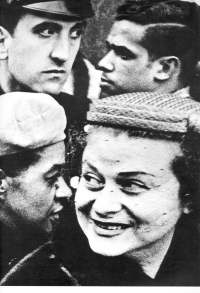 |
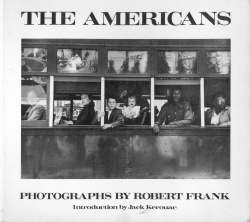 |
Robert Frank, "The Americans" (1959, 1968, 1978, 1988, 1998). A book
of 83 photographs which stand completely on their own (you are reminded of
Goya's 80 plates, "Los Caprichos"). A bitter social critique, a sad and
personal poetry of hopelessness, and a pointed review of photography -- it
can be seen, even, as a textbook on photojournalism. The integrity of
"The Americans" is absolutely amazing. And it stood photography on its
head. When it was reprinted in 1968 other photographers started to take
notice not just of the pictures, but of the book. The result has been a
flood of photo books, often entirely based on a misreading of "The
Americans" as a Modernist document.
"Frank killed the grandfather of photography," one freelance
photographer commented to me. The fleeting gestures caught in the first
three photographs of "The Americans" are nowhere repeated; one soon gets
the feeling that Frank's sense of timing is based on catching a more
general and unlikely gesture. In effect, a stance rather than a gesture is
caught. Frank's method, however, derives directly from the decisive moment
syndrome. A look at some of the contact sheets presented in "The Lines of
my Hand" (Yugensha edition, pp. 87-90) frequently shows Frank pouncing on
his subject. |
| Ed Ruscha "Twenty-Six Gas Stations" (1962), "Various Small Fires
and Milk" (1964) "Thirty-Four Parking Lots" (1967), "Every Building on
Sunset Strip" (1966), A Few Palm Trees (1971), and more. It was Ed Ruscha,
a printmaker and painter, who gave photographers permission to do books
outside of the rigid photojournalistic traditions. |  |
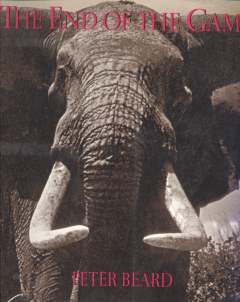
| Peter Beard "The End of The Game" (1967, 77, 88) The effect of
the book is entirely due to the editor who chose to do the presentation in
the style of what Northop Frye calls a 'Menippian Satire' or more commonly
known as 'encyclopaedic literature.' |
| The last exhibition catalogue of Hollis Frampton "Hollis
Frampton: Recollections, Recreations" (1984). Instantly recognizable as a
Menippian Satire, entirely befitting Frampton, who is actually a
filmmaker, but also one of the more astute photographic critics of his
day. See for example his collection of essays "Circles of Confusion" (see
below). | 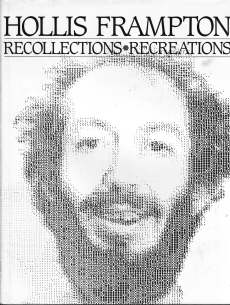 |
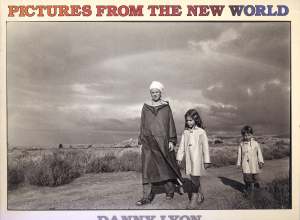
| Danny Lyon "The Bikeriders" (1968), "Conversations with The Dead"
(1971) Chicago based bikers. There is more by Lyons. I especially like his
"Pictures from the New World" (1981) |
| Lee Friedlander "Self Portrait" (1970),
"The American Monument" (1976) His compositional strategies show up in
"The American Monument" and are at times impenetrable. | 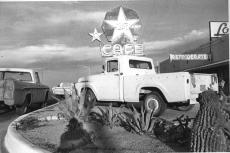 |
| Gary Winogrand "Stock Photographs" (1980),"The Animals" (1969),
"Gary Winogrand" (1976). | 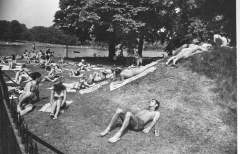 |
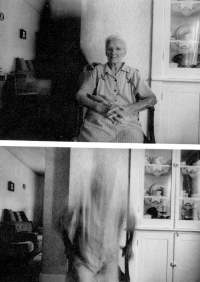 | Duane Michals "Sequences" (1970) and
others. There are a number of other. Some are very cute, few have any
depth. But they were very popular. |
| Ken Josephson "The Breadbook" (1974) A great response to the
popular Duane Michals Sequences, and typical of Josephson's laconic
approach to photography, and with a typical show of effortlessness. Not an
astounding success, for the book only sold for $3.50, but one of the best
visual critiques ever. It ought really be listed under "Criticism" below.
See [Visual Criticism in Photography] for an
article on the Bread Book.
| 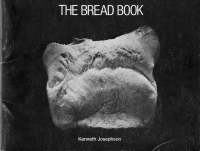
|
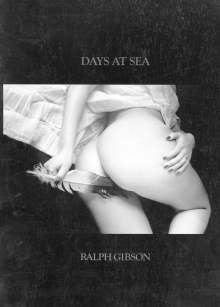
| Ralph Gibson "The Sumnambulist" (1970), "Deja-Vu" (1973), "Days
at Sea" (1974) Great sequencing, learned from Robert Frank. But no clear
message to me. Gibson was Lang's archiver before running into the work of
Robert Frank, which transformed him. He left for NYC, and even edited some
of Frank's films. He is an astoundingly astute photo-book editor.
|
| E.J Bellocq "Storyville Portraits" (1970, edited by Friedlander)
A great book of calling cards for New Orleans whores. | 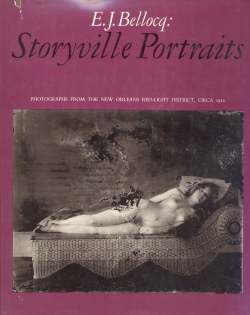 |
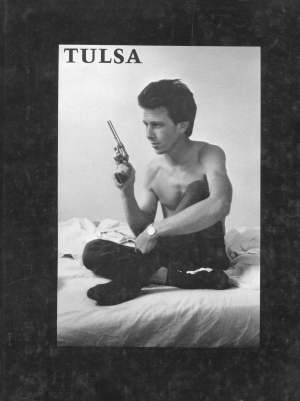
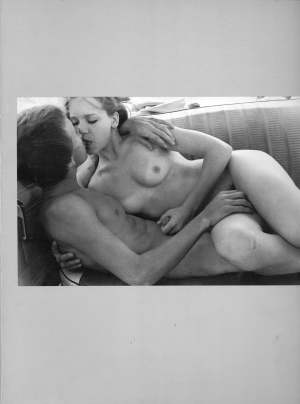
| Larry Clark "Tulsa" (1971) This became the most famous teaching
example among photo educators in terms of getting ideas across with
minimal text. But also a stunning book, since Clark was a participant in
the drug and gun scene, not an observer. Edited by Ralph Gibson -- which
is the strength of the book.
Clark's "Teenage Lust" (2 eds) pales by comparison. Introduced as
an autobiography, the book carries a rambling unpunctuated text, and is
filled with naked teenagers. The intriguing title was promised for nearly
10 years, finally came out in 1983, and republished later with more naked
teenagers. |
| Doon Arbus (ed) "Diane Arbus" (1972). Diane Arbus set the new
limits for photography in the 1970s, passing beyond all the boundaries of
what was allowed. Attendance at the exhibition of her work at MoMA
exceeded all other exhibitions of photographs. | 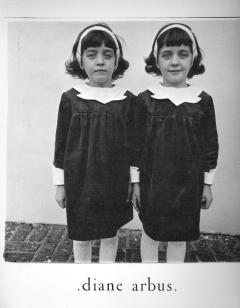 |
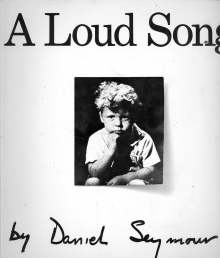
| Danny Seymour "A Loud Song" (1971) Edited by Ralph Gibson also. A
thin, minimal book, and mostly a story of getting off drugs - but
autobiographies don't sell well. Seymour is related to the Chicago Seymour
photographers, did camera work for Robert Frank. Drowned at sea on the
West Coast after the Rolling Stones got him back on heroin.
|
Robert Frank "The Lines of my
Hand" (1972). There are three editions, The first is an extensive, cased,
and large book, done in Japan, partially in Japanese. The second version
was edited down to a paperback by Ralph Gibson -- this is the one that
really packs some emotional power. And finally, there is an expanded
expensive glossy reissue by the Houston Museum of Fine Art, which loses
that power.
| Bill Owens "Suburbia" (1973) Wonderful. Only a close reading
determines that all the "recorded dialog" is made up by the photographer,
not that it is not uncharacteristic. | 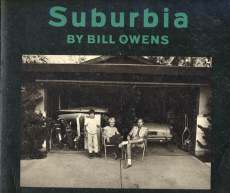 |
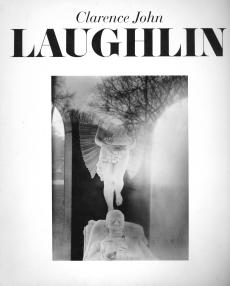
| Clarence John Laughlin "Clarence John Laughlin" (1973) An
absolutely gorgious book, centered on old New Orleans and environs, by a
romantic photographer who probably insists on adding way too much
interpretive text. |
| Michael Lesy "Wisconsin Death Trip" (1973) Entirely composed from
19th century found photographs. | 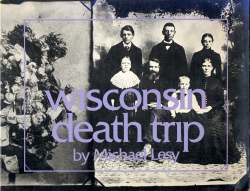 |
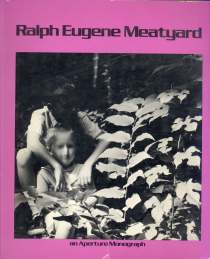
| Ralph Eugene Meatyard "The Family Album of Lucybell Crater"
(1974) Meatyard's photography is outstandingly bizarre and surealistic.
This book is the only whole-book effort, although it will disappoint you
if you are into 'nice photographs.' |
| Gaylord Herron "Vagabond" (1975) One of the few more-or-less
general "my greatest hits" I would allow for admission to this pantheon.
It is autobiographical, structured, and closely edited. | 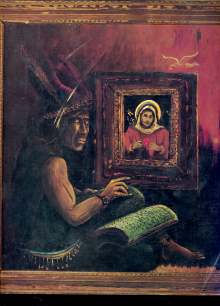 |
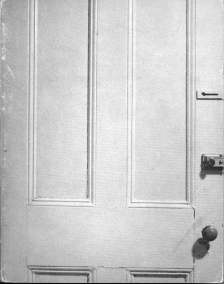
| Michael Snow "Cover to Cover" (1975) he is a Canadian film-maker.
A shot by shot compilation of front and back photographs which run through
the book like a film. At some points you will not know in which direction
you are reading. Totally iconoclastic and surreal. |
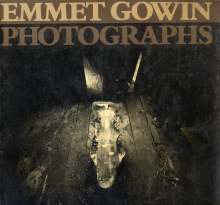
| Emmet Gowin "Photographs" (1976) Gowin received considerable
press in the late seventies for his presentation of photographs as
snapshots of rural family life (his family), with naive romaticized
overtones. View camera work, and frequently striking. His subjects make
the book. |
| Nancy Rexroth "Iowa" (1977) The standard of Diana Camera work,
competing with Conner, below. | 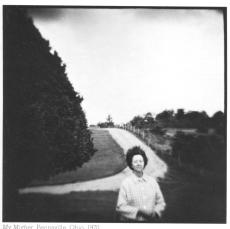 |
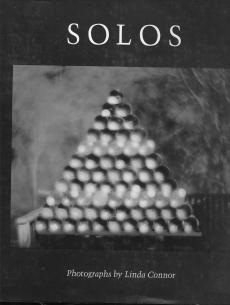
| Linda Conner "Solos" (1979) This book set the standard for
soft-focus camera work. |
| Chauncy Hare "Interior America" (1978) People of the Alleghanies,
and a very touching if not outright heart wrenching. |  |
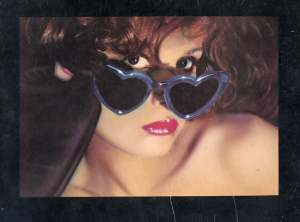
| Marcia Resnick "Re-visions" (1978) A Lolita-like envisioning of
staged photographs of the thinking of a young girl in the third person,
dismissed by the photo community, but absolutely wonderful (dedicated to
Humbert Humbert). |
| Keith Smith "When I Was Two" (1980, 2nd Pr) Offset, but photo
image based. A sort of coming-out book. Keith is a book maker.
| 
|
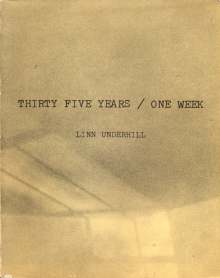
| Linn Underhill "Thirty Five Years / One Week" (1981). Offset, but
entirely photo-based. A stunning book in effectively presenting grief.
|
| Richard Avedon "In The American West" (1985) Full body straight
shots, stunning, no text. Shown here, though, is a shot from his
"Portraits" (1976). That work should be a primer. He had a reputation of
wearing his sitters down. Look at Marilyn Monroe. Eisenhower looks as if
his eyes are starting to wander. But he left that behind with "In The
American West" where most images were made before the sitter was
ready. | 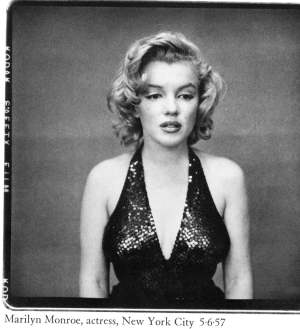 |
Histories and Criticism
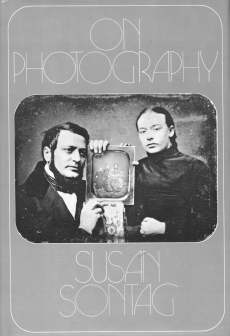
| Susan Sontag "On Photography" (1977). Disturbing to the
photography community in the 70s, because it is written by an outsider,
and caused endless discussions. Very varied in all the considerations she
brings up, but not deep. Still, a must-have book, which you will underline
and annotate page by page. |
| Hollis Frampton "Circles of Confusion" (1983). Absolutely my
favorite book of photographic criticism, but partially because of the
essayist's style (he covers some alternative film also). A book I have
read any number of times. Blows Sontag away. |  |
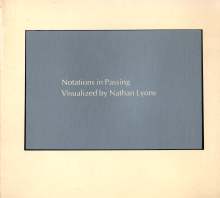 | Nathan Lyons "Notations in Passing"
(1974) A text-less visual critique on photography which goes over most
people's heads. Lyons runs the Visual Studies Workshop (Rochester NY), and
is a past photographic curator. |
| Nathan Lyons (ed) "Photographers on Photography" (1966) Much more
interesting to read what photographers have to say about photography than
what other tell. From Adams through Weston (actually Abbott through White)
-- 23 photographers. | 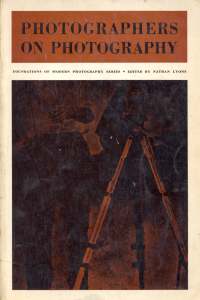 |
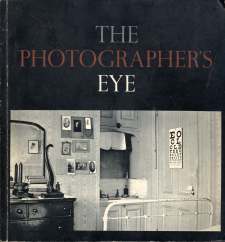
| John Szarkowski "The Photographer's Eye" (1966) An attempt to fit
a broad aesthetic classification schema to photography, probably more
concerned with style than form. 172 photographs by others, at times
grouped with more concern for topic than aesthetics. Nice book though, and
of some considerable influence. |
| John Szarkowski "Looking at The
Photographs" (1966) One hundred photographs from MoMA's collection, each
on a page, and reflected on by Szarkowski. Well written, interesting,
perhaps somewhat annecdotal, but never dry or descriptive. The images are
in historical order. | 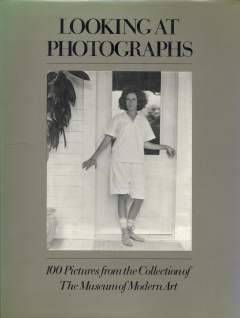 |
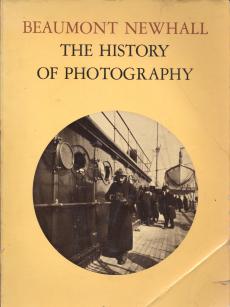
| Beaumont Newhall "The History of Photography" (1937, 4th edition
1964). Not withstanding various trade histories, and various texts of Art
vs Nature snipings among photographers in the 19th and 20th century, this
is indeed the first major history of photography since its inception a
1839 which consideres it an art form, and for years remained as the
standard text . Robert Frank only gets brief mention. |
| Arnold Gassan "A Chronology of Photography" (1972). The
chronology is only an appendix. Most of the book is text, well written and
much more interesting than art history. There is a portfolio also of
images. | 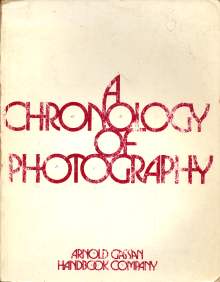 |

| Robert Taft "Photography and the american Scene" (1937, dover
reprint 1964). Completely devoid of any pretentions toward art, this is a
history of photography as business and commerce in the 19th century. But
all the same, very interesting reading. Some 300 illustrations. |
| Patricia Bosworth "Diane Arbus" (1984). Unauthorized and
disputed, a gabby 'biography' which in the end does not provide all that
much insight. But meet Robert Frank's kids eating bananas, and all the
weirdness you could imagine about Diane Arbus. |  |
Photography books represent a very limited market,
often not selling more that 1500 before being remaindered. "The Family of
Man" catalog is the notable exception. But it is over for cheap
self-funded self-published photographic books after 1980. In the 70s you
could get a book out for $2000. That would take you ten times as much
today.
Since the 60s and 70s a wealth of "artists books" have appeared,
mostly visually based, but often unfortunately short. These span from
single books to issues into the thousands. See Joan Lyons (ed)
"Artists' Books: A Critical Anthology and Sourcebook" (1985)
![[]](./bin/ailogo.gif)




















































